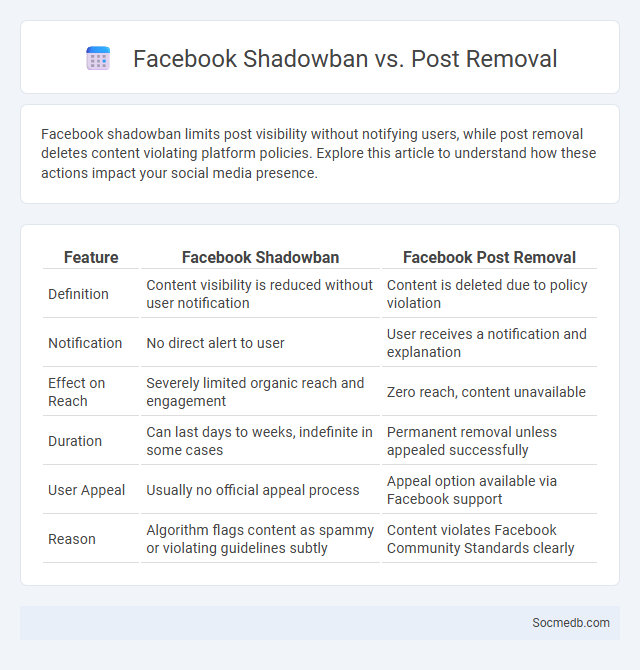
Photo illustration: Facebook Shadowban vs Post Removal
Facebook shadowban limits post visibility without notifying users, while post removal deletes content violating platform policies. Explore this article to understand how these actions impact your social media presence.
Table of Comparison
| Feature | Facebook Shadowban | Facebook Post Removal |
|---|---|---|
| Definition | Content visibility is reduced without user notification | Content is deleted due to policy violation |
| Notification | No direct alert to user | User receives a notification and explanation |
| Effect on Reach | Severely limited organic reach and engagement | Zero reach, content unavailable |
| Duration | Can last days to weeks, indefinite in some cases | Permanent removal unless appealed successfully |
| User Appeal | Usually no official appeal process | Appeal option available via Facebook support |
| Reason | Algorithm flags content as spammy or violating guidelines subtly | Content violates Facebook Community Standards clearly |
Introduction to Facebook Content Moderation
Facebook content moderation employs advanced algorithms and a global team of human reviewers to enforce community standards and remove harmful content such as hate speech, misinformation, and graphic violence. The platform integrates machine learning models to identify and flag inappropriate posts in real time while considering cultural and contextual nuances to minimize errors. Facebook's commitment to transparency is demonstrated through its regular Community Standards enforcement reports and appeals process, ensuring accountability and continuous improvement in content moderation techniques.
What is a Shadowban on Facebook?
A shadowban on Facebook is a covert restriction that limits the visibility of your posts without notifying you, causing reduced engagement and reach. This algorithmic action often targets content that violates community guidelines or appears spammy, making your posts less visible to your followers and wider audiences. Understanding shadowban helps you adjust your content strategy to maintain audience interaction and avoid penalties.
Understanding Facebook Post Removal
Facebook post removal occurs when content violates the platform's Community Standards, including hate speech, misinformation, or explicit material. Algorithms and human moderators work together to identify and take down offending posts to maintain a safe online environment. Users can appeal removals through Facebook's review process to contest decisions and restore content if deemed compliant.
Shadowban vs Post Removal: Key Differences
Shadowban limits the visibility of a user's content without notification, reducing reach subtly, while post removal involves the outright deletion of specific content by the platform. Shadowbanning affects overall account engagement by hiding posts from feeds or hashtags, whereas post removal directly eliminates individual posts that violate guidelines. Understanding these distinctions helps users navigate content moderation impacts and maintain compliance with social media policies.
Types of Shadowbans on Facebook
Facebook employs various types of shadowbans, including feed filtering, comment suppression, and group invisibility. Feed filtering reduces the visibility of Your posts without notifying You, limiting engagement and reach. Comment suppression hides Your interactions from other users, while group invisibility restricts Your posts from appearing in group feeds, all designed to minimize disruptive content without outright banning.
Common Reasons for Facebook Shadowbans
Facebook shadowbans often result from violations of community standards, including posting false information, engaging in spammy behavior, or sharing inappropriate content. Repeated reports by other users and automated detection systems can trigger restrictions that limit the visibility of Your posts without notifying You. Ensuring compliance with Facebook's guidelines and avoiding aggressive or manipulative engagement tactics reduces the risk of shadowbanning and maintains Your content's reach.
Triggers for Facebook Post Removal
Facebook removes posts that violate community standards, including hate speech, harassment, and misinformation. Content promoting violence, nudity, or illegal activities is also commonly targeted for removal to protect user safety. Your posts should adhere to Facebook's guidelines to avoid triggering automated or manual reviews leading to removal.
How to Detect a Shadowban on Facebook
Detecting a shadowban on Facebook involves monitoring significant drops in post engagement, such as sharp declines in likes, comments, and shares from your usual audience. Using Facebook Insights, analyze changes in reach and impressions over time to identify restricted visibility. Testing content visibility on different accounts or platforms may also reveal if your posts are being hidden or downgraded in news feeds.
Appealing Facebook Post Removals and Shadowbans
Navigating Facebook post removals and shadowbans requires understanding the platform's content policies, which target misinformation, hate speech, and community guideline violations to maintain user safety. Users can submit appeals through Facebook's Help Center if their posts are mistakenly removed or if shadowbanning occurs, ensuring transparency and the chance for content reinstatement. Effective strategies involve regularly reviewing Facebook's updates on allowed content and engaging with Facebook Support to resolve visibility issues promptly.
Best Practices to Avoid Shadowbans and Post Removals
To avoid shadowbans and post removals on social media, ensure your content adheres strictly to platform community guidelines and avoids spammy behavior such as excessive posting or using banned hashtags. Maintain genuine engagement by using relevant keywords, diversifying your hashtags, and interacting authentically with your audience. By focusing on quality content and compliance, you protect your visibility and maximize your account's reach.
 socmedb.com
socmedb.com